Shimano’s XT Di2 group has survived more than six months of testing. This second-tier electronic mountain bike drivetrain has proven itself durable with unmatched shift performance in a 1x11 group. But is it worth the price of admission?
Three ways to ride wired
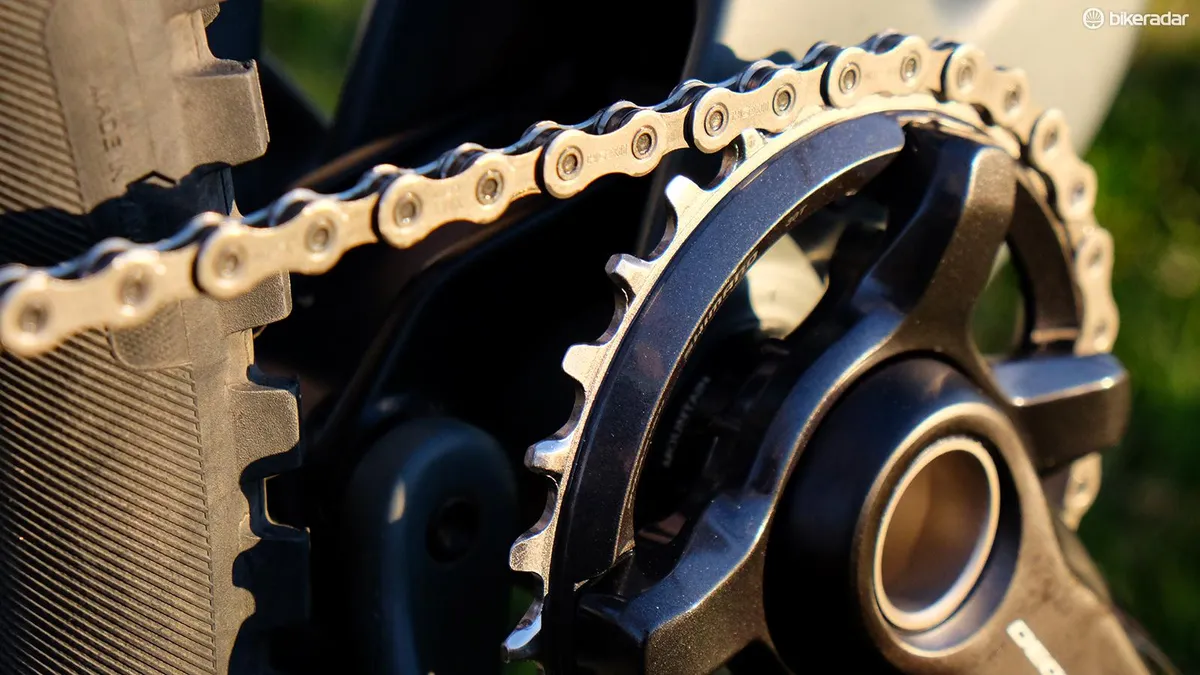
XT Di2 can be set up in three different ways:
It can be a 2x11 drivetrain with front and rear derailleurs controlled by individual shifters like a traditional cable-actuated drivetrain.
If you want the simplicity of a 1x drivetrain with smaller steps between gears, Shimano’s Synchro Shift technology provides the simplicity of a single rear shifter by using programmable gear mapping to automatically shift the front derailleur to keep you in the optimal gear as you shift through the rear derailleur.
Lastly, riders can use XT Di2 as a 1x11 system with Shimano’s narrow-wide chainring and the new 11-46t XT cassette, which is how this test bike is set up.
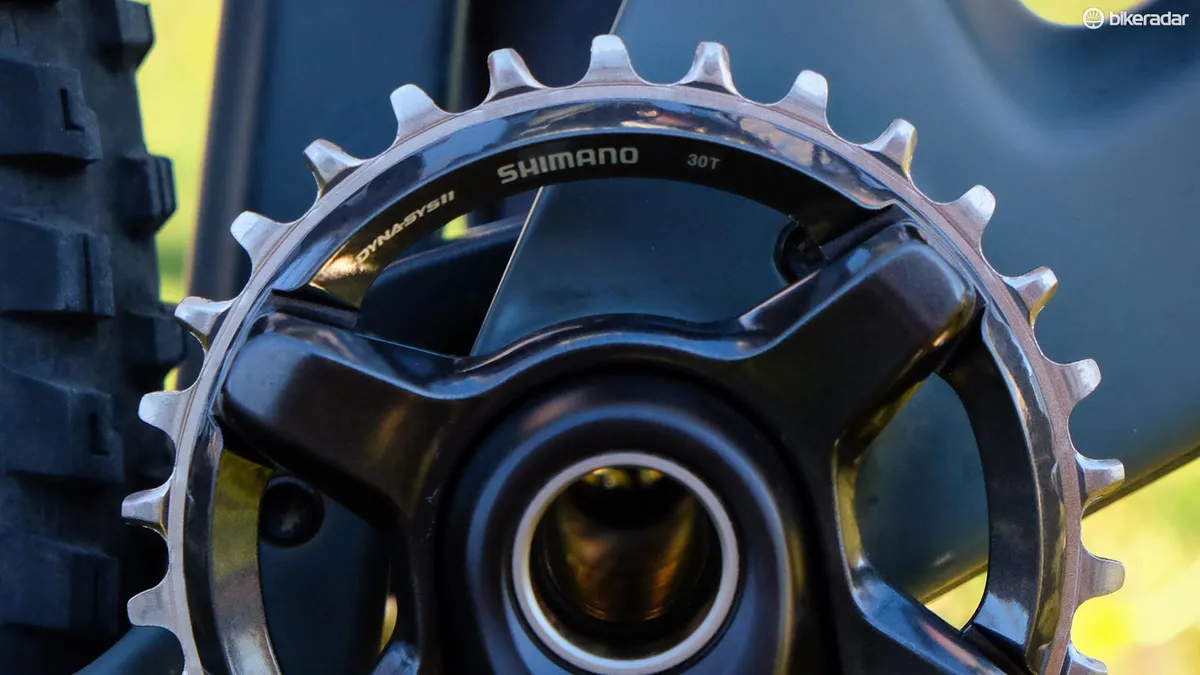
Electronics mean options
One of the primary benefits of Shimano’s electronic drivetrains is the multitude of ways riders can customize functions to suit their particular needs.
This customization starts with functions of the shift paddles. The default arrangement is opposite of the lever operation of Shimano’s cable-actuated drivetrains: the lower shift paddle shifts into a lower gear and the smaller, upper paddle shifts the derailleur into a higher gear.
I quickly realized that I preferred the levers to operate in the opposite manner. I found it easier to use the lower lever to shift into a harder gear because it allows me to keep more of my hand wrapped around the grip when riding downhill or sprinting out of the saddle.
According to Shimano’s mountain bike marketing specialist Joe Lawill, riders seem to be split evenly as to how they like their shift paddles to function.

In addition to swapping shift functions, I sped up the shift action from slow to medium. XTR Di2 allows riders to double-click the shift paddles to fire off one or two shifts at a time, but XT Di2 lacks this functionality.
However, it’s possible to continue shifting across the cassette by keeping a shift paddle depressed. There are slow, medium and fast shift actions to choose from.
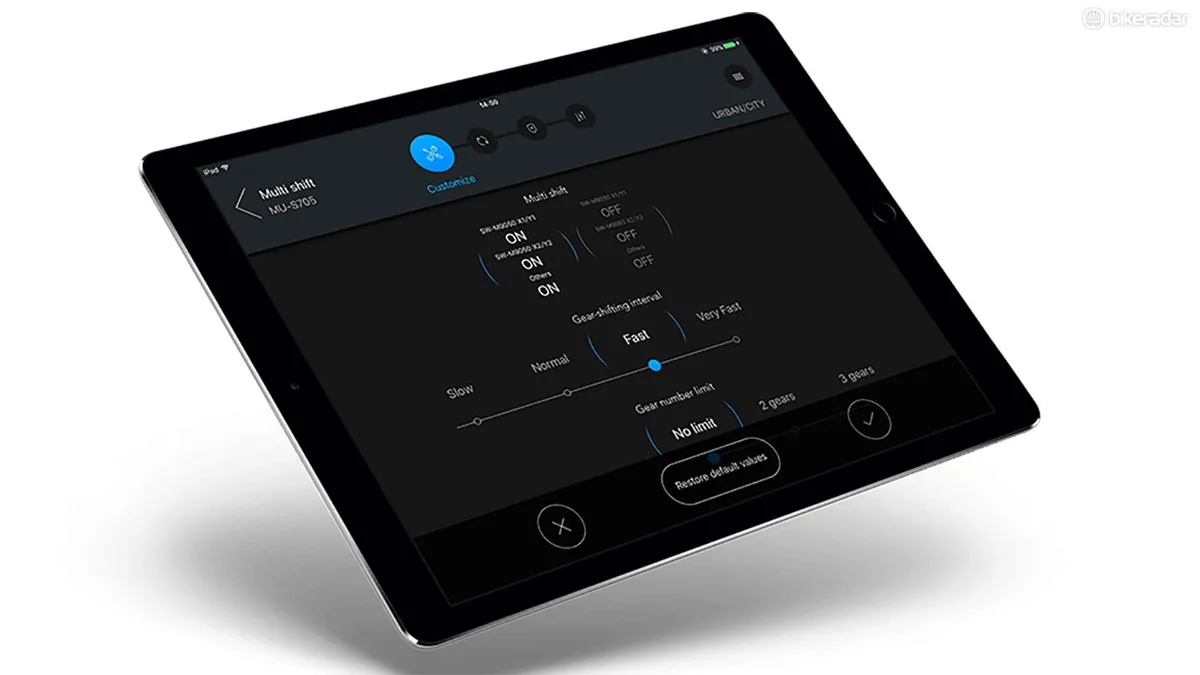
Thanks to the new wireless functionality that debuted along with this new group I was able to make both of these electronic adjustments on an iPad at the trail-head.
When I began my test last fall, it was only possible to make these changes when plugged into a PC, or wirelessly with an iPad-based app (iPad 3 or newer). Shimano has now released iPhone and Android apps, which makes it easy to make trail-side adjustments.
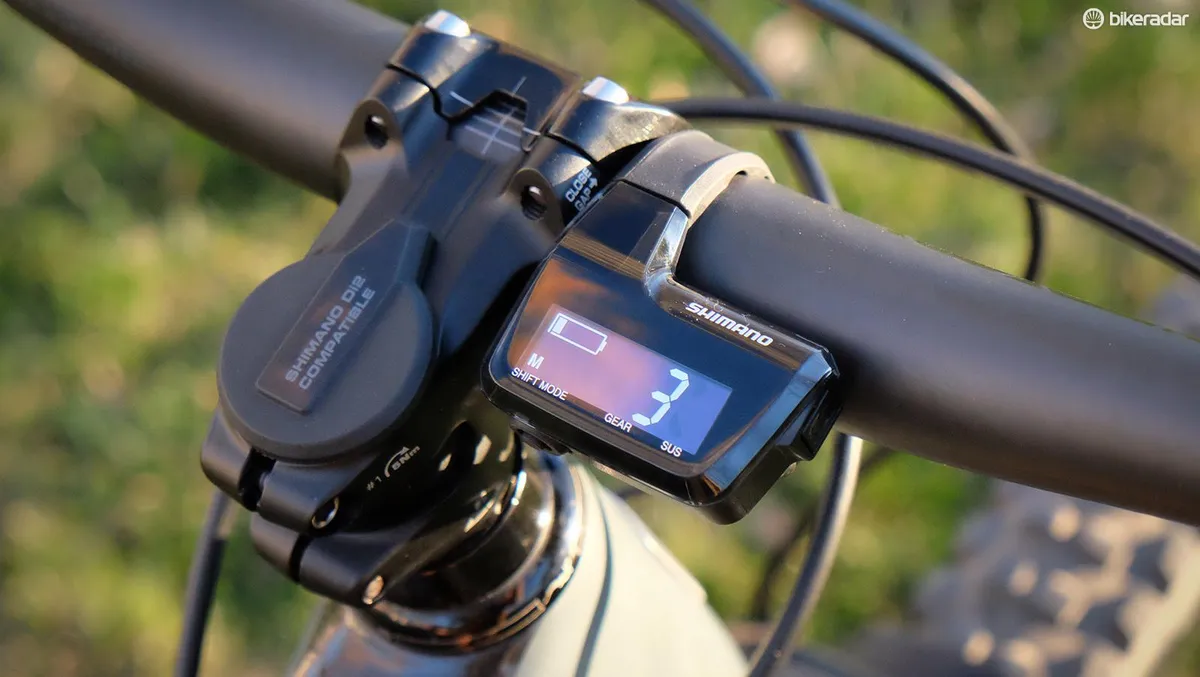
In addition to showing your current gearing, the SC-MT800 display also shows battery level, shift mode (manual or Synchro) and the suspension setting when used with the Fox iCD system.
In the case of my Shimano Tallboy test mule, the BT-DN110 battery, which also houses some of the brains of the system, is tucked inside the steerer tube.
Since the battery is out of reach, recharging is carried out through a charging port on the side of the head unit.

Battery run times were something that riders were initially wary of when Shimano rolled out Di2 on the road back in 2009. Since then, weekend warriors have been able to go months between charges, and professional cross-country and enduro racers have been able to make it through stage and enduro races without a worry.
Battery life for this system is impressive. Since testing began last November, I've recharged the battery three times. This run time is significantly longer than riders running a 2x system will encounter. In comparison to the rear derailleur, the front derailleur is a bit of a battery hog.
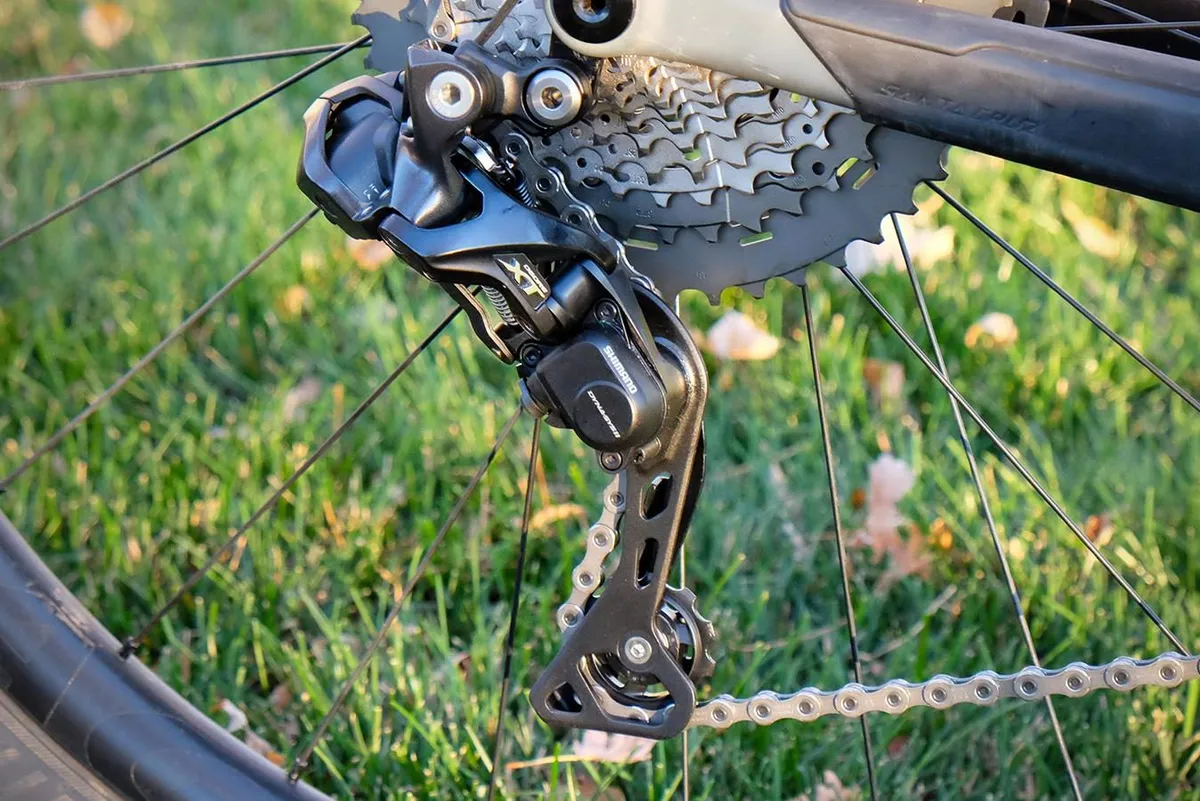
The last piece of this electronic drivetrain is the rear derailleur. The XT M8050 Di2 Shadow RD rear derailleur has a low-profile design to keep it out of harm’s way. The large servo motor is positioned at the back of the derailleur body.
The b-tension and limit screw adjustments are handled by 2mm hex screws. Once you’ve fine-tuned these adjustments the rest of the derailleur set up is quite literally plug-and-play.
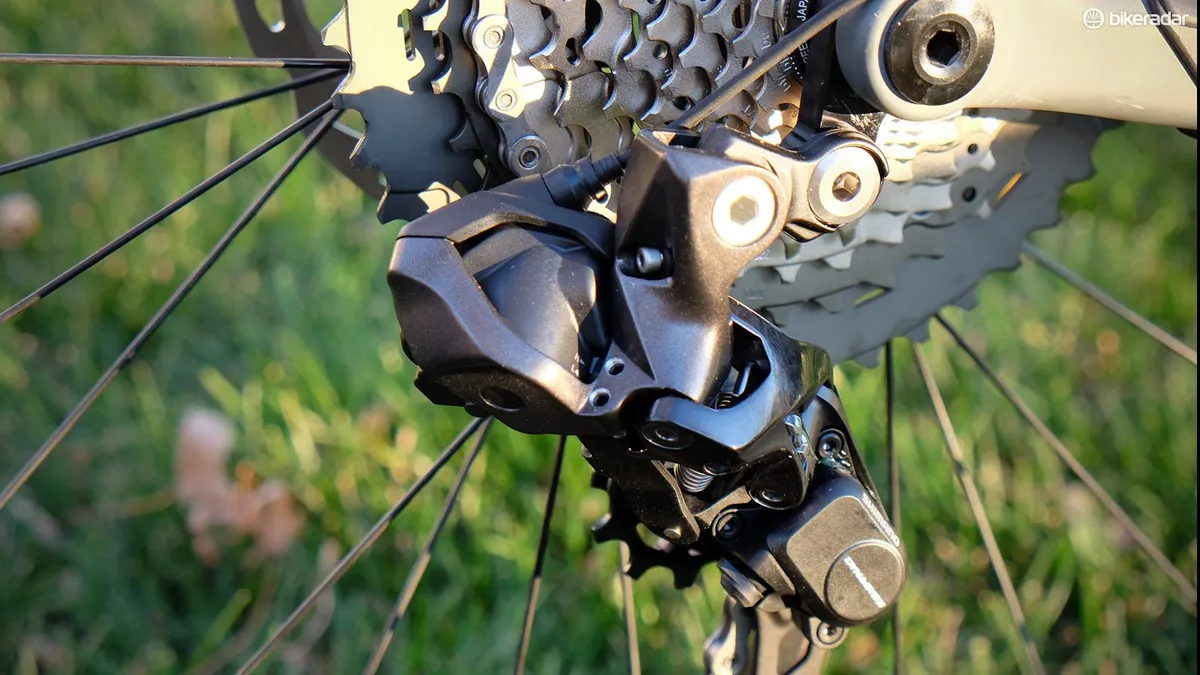
Ride impressions
After Josh's first day on the trails with Shimano's XT Di2 these were his initial impressions
The tactile feedback from the paddles mimics the lever feel of Shimano’s cable-controlled drivetrains, with a few millimeters of freestroke before meeting a reassuring click. In addition to electronic customization, each shift paddle has approximately 10mm of lateral adjustment via 2mm hex screws.
The satisfying tactile feedback from the shift paddles is accompanied by an audible beep when you reach the end of the cassette’s range. I found this more useful than the display, which I never glanced at while riding.
Chain retention on Shimano’s narrow-wide chainring is as good as any other system and shift performance is fast, smooth and precise.
It’s great to see a wider range cassette from Shimano, but the 11-46t cassette does leave something to be desired.

The tooth count is as follows: 11-13-15-19-21-24-28-32-37-46t. The step from 37 to 46 is a very significant jump in gearing for a company that has cited large gaps between gears as one of its primary reservations with 1x drivetrains.
This massive jump takes away from the otherwise flawless shifting. In my opinion, this cassette feels like a stopgap product, hastily developed to address the demand for wider range 1x options from SRAM and after-market manufacturers.
Gaps in gearing aside, Shimano’s XT Di2 drivetrain brings the performance of the top-end XTR Di2 group to a (slightly) more attainable price point. It's incredibly customizable, and the introduction of smartphone apps for both Android and iPhone makes it truly adjustable by any rider.
Great group, but is it worth it?

After many months of testing, XT Di2 is still performing flawlessly. So is it worth the investment?
Well, that’s a complicated question. Let’s break things down in terms of performance, positioning, ease of installation and value compared to the competition.
Performance
Shimano still reigns supreme in terms of shift performance. XT Di2 shifts smoother, quicker and with a level of accuracy that gives it an edge on any of SRAM’s 1x11 or 1x12 groups.
Positioning
To date, this is Shimano’s widest range 1x group. While it offers a larger bail-out cog than SRAM’s 1x11 groups, all of SRAM’s 1x12 groups and many aftermarket 1x11 options out gear it.
Cassettes from manufacturers such as e*thirteen offer a wider range and upgrade cogs from companies such as Wolf Tooth and OneUp can give your existing 11-speed Shimano or SRAM cassette more range. These upgrade options certainly don’t have the shift performance of XT Di2, but they don’t cost nearly as much, either.
Ease of installation
Shimano contends that installing one of its Di2 groups is no harder than a traditional cable-actuated drivetrain, merely a bit different.
In my experience, this is highly dependent on the make and model of the frame in question.
Some brands, such as Pivot Cycles, have thoroughly embraced Di2 compatibility and offer Di2-specific wire ports and a cover on the down tube or bottom bracket shell to house the battery.
Other bikes, such as the Santa Cruz Tallboy I used for this test, present a few challenges when it comes to housing the battery, junction box and tidying up the wiring.
None of this may concern you if you’re buying a complete mountain bike with XT Di2, but it’s something to be aware of if you’re considering the upgrade.
Additionally, I have no idea what's coming down the pipeline, but I have a hard time believing that the future of electronic mountain bike drivetrains will be wired.
Value
Is marginally better shifting worth the investment?
The cable-actuated XT drivetrain costs a fraction of its electronic sibling — you can outfit three bikes with mechanical XT drivetrains for the price of the complete XT Di2 group.
Considering the steep price tag along with the fact that SRAM offers top-end 1x12 groups in XX1 and XO1 Eagle with more range and a very budget-friendly 1x12 GX Eagle group, it’s hard to make the case that XT Di2 is worth the price.
Arguably, the only configuration where XT Di2 might have a competitive advantage over SRAM and aftermarket players is when run as a 2x11 system with Synchro Shift.
Verdict
While XT Di2 has impeccable shifting, outstanding battery life, and has proven very durable, the gear range and price tag don't add up. Unless you consider yourself a tech geek, who is intrigued by electronic shifting, this is a hard group to justify.
This article has been updated from a first ride review to a full, scored review since it was first published so some comments below may be out of date.

